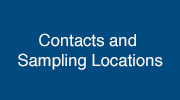The California Harmful Algal Bloom Monitoring and Alert Program (CalHABMAP) is a coordinated response network for efficient HAB mitigation, prediction and prevention. CalHABMAP provides updates on current algal blooms and facilitates information exchange among HAB researchers, managers and the general public in California.
A major component of this program is regional HAB monitoring. Water samples and net tows are collected once per week to monitor for HAB species and naturally occurring algal toxins. Water quality data including temperature, salinity, and nutrients are also collected.
The HAB groups of greatest concern to California are Pseudo-nitzschia and Alexandrium, since some species can produce potent algal toxins that can be transferred through the food web to higher organisms such as marine mammals and humans.
Statewide HAB data is synthesized and distributed via the California HAB bulletin on a monthly basis. Brief, weekly email updates from each monitoring location about basic water quality parameters and presence of potential HAB taxa are circulated via the CalHABMAP listserve.
For information on statewide closures and monitoring efforts see: CA Dept. of Public Health, Marine Biotoxin Monitoring Program.
One Health Harmful Algal Bloom System (OHHABS) collects data on harmful algal blooms and associated human and animal illness. OHHABS provides information about harmful algal blooms and associated illnesses for the general public, including ways that people can protect themselves, their families and their pets.




